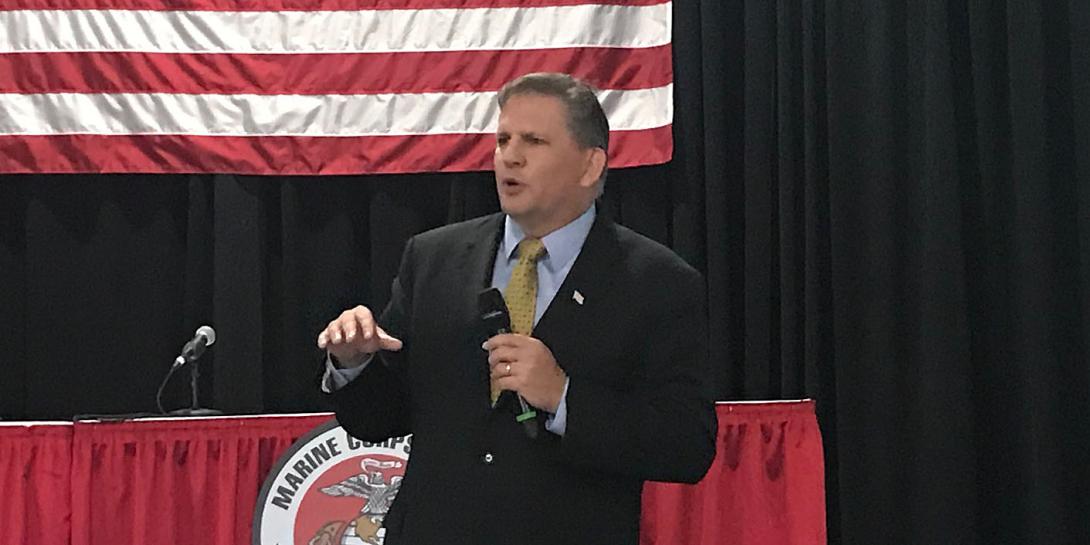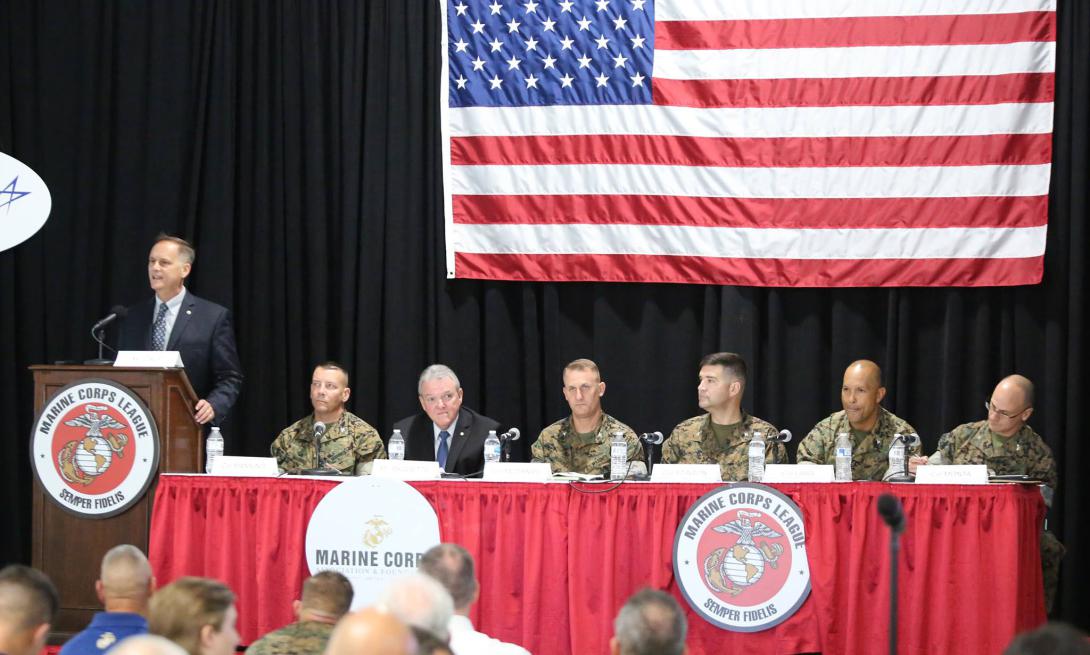Marines Corps Outlines Technology Needs
The move away from technologies meant for a static battlefield environment continues for the U.S. Marine Corps, as the service fields technologies needed for operating in austere environments.
Leaders want ruggedized and resilient technologies that are low in size, weight and power for soldiers on the move. The technology gaps to fill come across all aspects of command, control, communications and computing, or C4. Marine Corps leaders identified the service’s top technological needs during the Modern Day Marine event September 25-27 at the Marine Corps Quantico base.
One of the main commands looking to harness C4 technological advances is the Marine Corps Systems Command (MCSC), which is responsible for equipping Marines with ground weapon and information technology systems. The command is led by Brig. Gen. Arthur Pasagian, USMC, who was selected in May for the position following his assignment as the command’s chief of staff. Jack Cave, director of programs, MCSC, spoke at the event on behalf of the general. Cave said that the new commander was looking for MCSC program managers “to execute their programs in the most efficient and effective manner possible. We are trying to look ahead and see where they are going to encounter obstacles and push them through. It is all about speed of relevance and getting capabilities out to the operating forces.”
Gen. Pasagian is asking MCSC officials to interact more with joint partners from the Army, Air Force and the Navy; get out to industry more frequently “to see what you are doing;” and “most importantly, get out to the operating forces,” Cave said. “We must understand operational necessity.”
Following a 2017 restructuring, the MCSC is responsible for integrating Marine Air-Ground Task Force (MAGTF) products into the command’s four MAGTF-aligned equipment portfolios: Command Element Systems (CES), Ground Combat Element Systems (GCES), Logistics Combat Element Systems (LCES) and Supporting Establishment Systems (SES). The command’s alignment with the MAGTF is to make sure “we are getting the right capability to out to the Marines,” Cave noted. “I don’t think that before we envisioned the austere environment that soldiers will have to operate in when we developed capabilities initially. This is critical and we’ve organized as such.”
The CES portfolio includes more than 100 programmatic efforts, ranging from Science and Technology (S&T) research to sustainment, with a $6 billion budget, according to Col. Brock McDaniel, USMC, CES portfolio manager. “We have a vast amount of systems that we could use industry help with, and we’d like to especially see the capabilities that industry has on the horizon,” he said.
The program needs communications, command and control and intelligence systems that are expeditionary, streamlined and smaller, “to go anywhere around the world,” Col. McDaniel stressed. “Remember pounds equal pain. We have to reduce the size of systems. They have to fit in the back of a V-22 or a ship.” Any industry offerings have to be resilient to operate in garrison, deployed and contested environments. “For C2 this is extremely important,” he said.
The CES is looking for the industry to provide cybersecurity, reduce the costs and size, weight and power of technologies, supply signature management technologies and offer converging capabilities, Col. McDaniel noted. “For cyber, we need to strengthen our systems, and at the same time, we need to be able to understand internally how we are more vulnerable and what do we need to do to mitigate those things,” he suggested.
The need for signature management technologies is “a big one,” the colonel continued. “We just can’t light up like a Christmas tree on the battlefield. We’ve got to figure out how to reduce our electromagnetic signature or even mask that signature, and at the same time exploit the enemy’s signature. The bottom line is that I want to own and control the electromagnetic spectrum. We have a significant opportunity to enhance our EW [electronic warfare], EA [electronic attack], direction finding and networking capabilities, and we want to do this in both the dismounted and mounted capabilities. So we need your help in both arenas.”
In addition, technologies need to be interoperable. The CES wants the industry to provide emerging routers, switches and servers and offer converging capabilities while at the same time modernizing them. “We want less boxes and more capability,” Col. McDaniel said. “And we are looking for the military discount on everything.”
With the help of the SES program, the CES is pursuing network modernization as one of its major efforts—modernizing in the garrison, tactical arena and in operationalizing the defense information groups (DIGs)—the colonel explained.
The CES also is continuing its MAGTF Common Handheld program, which enables dismounted Marines to use commercial smart devices for reference and tactical sharing, according to the command. “The MAGTF common handheld is our effort to put C2 and SA [situational awareness] and kill line information into squad leaders hands,” Col. McDaniel confirmed. Here, the Marines see the configuration as a tablet or phone-size. “Really, the security is the key part we need industry assistance on,” he explained. “We need a commercial solution for classified that has Type 1 encryption wireless capability.”
In May, the command issued a request for information (RFI) for industry feedback on a next-generation troposcatter system to replace the existing system. “Our troposcatter has been around since Moses was a Marine,” the colonel lamented. “It is time to replace it. We need C-Band and X-band capabilities that have increased power and distance capabilities, and as small as possible.” The systems could be combined or separate C-Band and X-band systems.
Regarding satellite communications (SATCOM) capabilities, the Marines rely on other services and the commercial industry to put up the satellites, but manage their own terminals and workstations, the colonel said. “Here, we are looking to modernize, and again, they have to be expeditionary, smaller and offer increased capability.”
In addition, the CES “has lot of opportunities in the waveform arena,” Col. McDaniel said, as the program is looking to modernize radio technology to meet a National Security Agency (NSA) mandate for encryption. “We are looking to replace our HF [high frequency] capability, improve our multiband capability, and improve our multichannel capability,” he offered. “I will tell you proprietary waveforms are a difficult thing for us to swallow, however. We would like to get to a point where technology can be waveform agnostic, to be able to give our Marines the maximum capabilities possible and not be locked into a single solution.”
At the same, CES is looking to enhance data processing, information and dissemination of imagery, “not just in the big garrison locations, but also at the handheld level, where our Marines can be deployed and get real-time, up-to-date information,” Col. McDaniel stated.
Col. Ben Stinson, USMC, portfolio manager, SES, known as “the enterprise IT [information technology] folks,” said the portfolio is pursuing an acquisition velocity strategy, which kicked off two months ago. Language in the National Defense Authorization Act and from DOD is allowing the command to implement agile software development as their method to get products to the warfighter sooner. “This means no more waterfall software development,” he said.
The SES is looking to develop a “digital twin” platform for part of the network. “We need industry’s help in setting this up,” he noted. “I can’t go fast unless I have a place that I can use as a playground, where I can break things and it doesn’t harm the network.”
The portfolio will work with warfare centers and the Marine Corps Tactical Systems Support Activity. And the effort will include a concerted effort to get industry involved along side the testing process. “We need to virtualize our environment for testing and still have hardware in the loop,” Col. Stinson added.
For the enterprise IT systems, the colonel stressed the power of data and analytics in data processing and that they will be looking to artificial intelligence and machine learning. “We’ve got stovepiped systems that track data, and we have to enter things multiple times, multiple systems to track contracts, finances, program management, and engineering,” the colonel stated. “We can’t lock and unlock or unleash the value of our data. We are broken there. We want to crack this wide open and find ways to take all these stovepiped databases and share information to provide powerful and timely decisions for decision makers.”
Meanwhile, Col. James Geurts, USAF (Ret.), assistant secretary of the Navy for research, development and acquisition, stressed the importance of an aggressive contracting strategy for (S&T). Prior to his current post, Geurts was in the Senior Executive Service and oversaw research, development, acquisition and logistics for the U.S. Special Operations Command (SOCOM). At SOCOM, over time, officials “developed 17 ways of buying things,” Guerts said, adding that for the Marines and the Navy the approach would be “no different. We need to be creatively compliant [with acquisition].” This means relying on other transactional authority (OTA), small business innovation research (SBIR) and federal acquisition regulation (FAR)-based contracts. “Yes, to it all, we must be proficient in all acquisition tools,” Guerts noted.






Comments